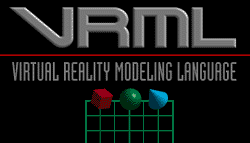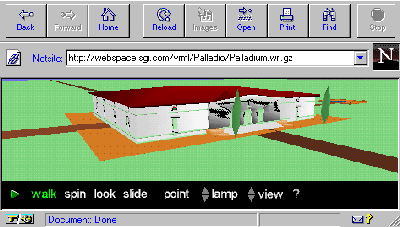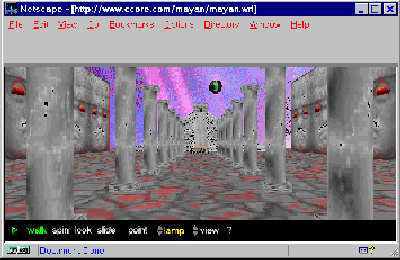
"On Pueblo, teachers try to help students direct and organize their learning. They give them specific tasks, hand out special binder notebooks. There is a different vibe on Micro, an anti-curriculum sentiment that considers too much teacher direction a direct blow to student creativity. The kids on Micro only log on when they care to. There are rooms with automated tutorials on how to do projects, but mostly what they have to do is figure out themselves what it is they want to know and what they want to make" Jessica Chalmers  "Click on objects and you'll move towards them. Click on the various swimming animals and you'll be able to ride them. Or you can chose from Viewpoints menu. While riding the different characters, you can also excercise some control over your viewpoint and range of view by slowly moving the rolling ball and/or the zooming lever. To find links to other worlds, keep clicking on the objects. Beware, there are predators as well!" From a site created by Ryoichiro Debuchi
 "Students could have contact with people from cultures and subcultures outside their own. They could construct their own spaces and try on new personas, new ways of thinking, new ways of interacting. They would get immediate responses to their ideas and to the text objects they created, experiencing dynamically the effects their words have on others. Perhaps most intriguing, MUDs could disrupt the hierarchy of the traditional classroom, giving students more power and responsibility and a chance to learn to use it wisely in order to accomplish their goals."Tari Lin Fanderclai
"Because students would be unseen and relatively anonymous, we hoped that they would feel more comfortable expressing themselves. Because everyone can talk at once and everyone is heard, no one could dominate discussions. The teacher could not stand in front of the room and lecture and direct; students would have to be responsible for their own actions and develop their own methods for accomplishing their goals."Tari Lin Fanderclai
|
VRML or Virtual Reality Modeling Language is a standard language for three-dimensional objects, scenes or 'worlds' delivered
across the internet. It can also allow for interaction and manipulation of the objects or scenes and examination of them from all viewpoints. In the case of VRML worlds, these can be animated and allow for the user to create an avatar or symbolic representation of him/herself in order to actively move about and interact with other users/avatars in a 3d space such as a 'room' or 'gallery'. VRML multi-user worlds, a standard which is still developing through experiments going on now, adds visual information and 3D objects to MUDs (Multi-User Dimensions or Multi-User Dungeons) which are currently text-based. VRML requires a web browser with a VRML plug-in or helper application.Most VRML worlds can be viewed with 16 MB of RAM or less, but the very largest require up to 32 MB. VRML generally requires newer, more "state of the art", operating systems with fast CPUs such as a 75 MHz Pentium, and fast Internet connections. It is likely that many or most schools would presently not be equipped with the hardware to be able to make use of VRML to complement instruction. At the same time, the majority of VRML sites are not designed for educational purposes rather many of them cater to interests of entertainment. This is particularly true of Multi-User Worlds. Thus, education has yet to be able to benefit from the learning opportunities that such environments could potentially offer. Future educational use of VRML could involve simulations such as interactions of chemicals, growth of cells or crystals, 3d representation of worlds in space or underwater. VRML also presents the possibility of collaborative spaces for student interaction, seminars, tutorials and informal gatherings such as those that might be provided by virtual classrooms and universities.
|
|---|
|
©1997, Elizabeth Murphy, St. John's, Newfoundland, Canada. Thanks to Bob Crispen who read and revised a first draft of this document. This page was designed to be viewed at a resolution of 640 x 480 with a browser supporting tables. Your comments are welcome! |
| BRAVE NEW WORLDS |
ADAPTIVE HYPERTEXT & HYPERMEDIA |
|---|
